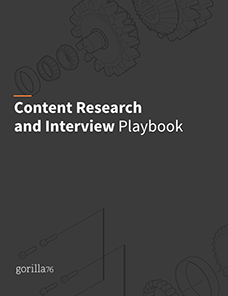1. Content Research and Interview Playbook
 This simple tool will help prepare you and your team to create valuable, expert content. It includes a list of steps for researching the topic at hand, as well as a list of steps for conducting an interview with your company’s subject matter expert. Click the image below to instantly download the PDF.
This simple tool will help prepare you and your team to create valuable, expert content. It includes a list of steps for researching the topic at hand, as well as a list of steps for conducting an interview with your company’s subject matter expert. Click the image below to instantly download the PDF.
2. Audio clips from real-life interviews
As promised, below are three selected audio clips from real interviews we conducted with client subject matter experts. The interviews, combined with independent research, resulted in vital resources published on our clients’ websites.
Clip #1 – Lead Metallurgical Engineer
Here, I’m speaking with the lead metallurgical engineer of a major North American thermal processing firm. It’s a weedy discussion about case hardening of automotive components and why differing case depth measurements are specified. Case hardening, by the way, is a heat treatment that imparts carbon, nitrogen or both to the surface of metal parts like gears or shafts so that they can withstand constant wear and severe torque loads.
Here’s the article that resulted from the interview. Here’s some key points:
I acknowledged right away that I was about to ask a potentially stupid question. It’s tempting to want to self-censor to avoid sounding like a novice. Ignore that impulse and ask the questions you need to ask to understand a topic.
At around 4:10, I had a hunch I was missing something important. The follow-up question I asked wasn’t initially in my notes, but I went off-script. The payoff? A more detailed picture emerged regarding why differing case depth measurements matter to different applications.
At around 6:20, I asked about a common standard. I didn’t know whether it was arbitrary or grounded in hard science. I ultimately did not expand on that in the article, but it aided my understanding of metallurgy in general. The science has come a long way from whacking parts with hammers as a testing method.
Clip #2 – Another metallurgical engineer
This interview is with the same company but with a different metallurgist and the firm’s marketing manager. The topic is hot isostatic pressing (HIP), a process where complex metal parts are heated to well over 2,000 degrees Fahrenheit in vessels reaching pressures up to around 25,000 pounds per square inch. We’re talking about how HIP eliminates small voids formed when aerospace components are manufactured via powder bed fusion (a technical term for 3-D metal printing).
Here’s the article. Listen for these key exchanges:
I started with a rudimentary question about how HIP relates to powder bed fusion. It’s normally the sort of basic question I try to avoid, but my independent research had not been conclusive. The internet is full of information, but almost none of it covers advanced thermal processing of 3-D-printed jet engine parts.
Four minutes into the clip, I mentioned a 25-year-old informational video I found on YouTube. The video’s narrator made a claim I believed wasn’t necessarily true in the context of our discussion. Rather than assume I was right, I wanted the metallurgist to confirm and explain why. The point: Be skeptical of what you find during research andbe skeptical of what you think about it. Here’s one of my most basic rules as a writer: Don’t guess.
Clip #3 – Vice President
Here, I’m speaking with the Vice President of a process piping and piping system fabrication firm specializing in ultra-high purity microelectronic and aerospace applications. We’re talking about quality control and material segregation, something that’s critically important when piping and systems are designed for use in the cleanest manufacturing environments on the planet.
The interview resulted in this overview page. Key notes from this clip:
The clip begins with me asking the expert to expand on a topic we’d covered in previous conversations. The page we were creating needed to more fully address the topic of quality assurance / quality control.
At 2:18, I went off-script to ask about redundancies in quality inspections between this firm and raw material manufacturers. I was only curious, but I ended up learning about why the firm double checks its suppliers’ work. It’s a feather in their cap that gives them credibility over competitors.
Around 4:30, I asked about a piping standard I’d come across during research. Navigating the spider web of piping and welding standards can be confusing, and I wasn’t sure how (or even if) this one applied to our conversation. Turns out, it didn’t. Again: Don’t guess.